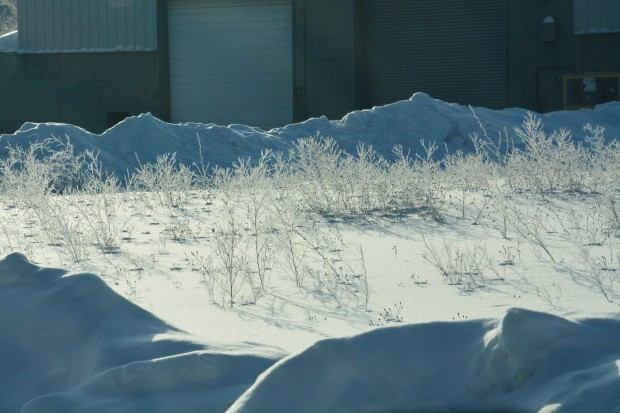 Our winter, which shows not one sign of abating, has been our snowiest and coldest for 20 years. My landscape has rarely been subject to temperatures below zero – never the extreme below zero numbers that have been routine this winter. A worst case winter like this is bound to have consequences. I fear the spring may not only be an awakening, but could well be a rude awakening. Have I planted marginally hardy species in my garden? Yes. Magnolias and dogwoods are somewhat marginal here. Other trees common to my area, as in redbuds, London Plane trees, sweet gums (liquidambar), and even tulip trees are very sensitive to extreme cold. Many specialty evergreens that thrive in the Pacific northwest that have been planted in my zone may not fare so well. I have already seen many Alberta spruce with substantial cold burn. I know of several long established sweet gums who routinely have crown dieback in a middling cold winter. What will happen to them this year? Furthermore, years of reasonable winter temperatures have encouraged me to try plants that are on the edge of my hardiness zone. This has worked for many years. This year, I may be in for a little course correction.
Our winter, which shows not one sign of abating, has been our snowiest and coldest for 20 years. My landscape has rarely been subject to temperatures below zero – never the extreme below zero numbers that have been routine this winter. A worst case winter like this is bound to have consequences. I fear the spring may not only be an awakening, but could well be a rude awakening. Have I planted marginally hardy species in my garden? Yes. Magnolias and dogwoods are somewhat marginal here. Other trees common to my area, as in redbuds, London Plane trees, sweet gums (liquidambar), and even tulip trees are very sensitive to extreme cold. Many specialty evergreens that thrive in the Pacific northwest that have been planted in my zone may not fare so well. I have already seen many Alberta spruce with substantial cold burn. I know of several long established sweet gums who routinely have crown dieback in a middling cold winter. What will happen to them this year? Furthermore, years of reasonable winter temperatures have encouraged me to try plants that are on the edge of my hardiness zone. This has worked for many years. This year, I may be in for a little course correction.
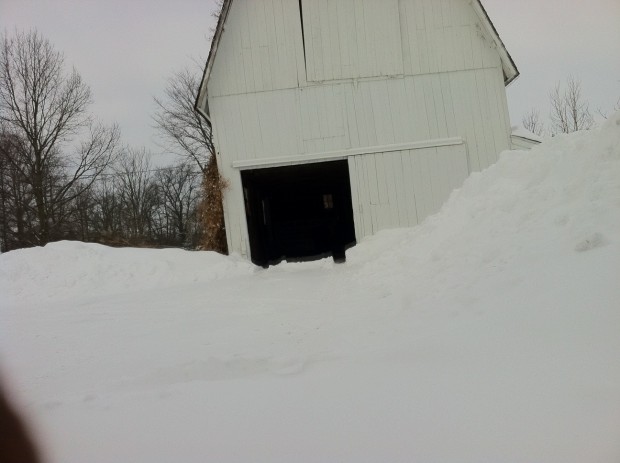 I am not a worst case alarmist. It could entirely be that I will see little damage. But professional growers I have known for years are concerned about what our spring will bring. I have magnolias which are definitely a zone 5, and maybe a zone 6. For 18 years, those trees have done better than survive. But weather cycles are much longer than my gardening lifetime, and the lifetime so far of my landscape. I am quite sure there is not a single plant in my yard which is 100 years old or better. Bob Schutski, professor of horticulture at Michigan State and well known lecturer in landscape practices, predicts we will have no magnolia flowers this spring. Ouch. I hear of peach growers in Michigan talking about total crop loss. My gardening friend Michael whose barn is pictures above-his mountains of snow may be the least of his worries. He has trees and mature shrubs missing their bark above the snow line.
I am not a worst case alarmist. It could entirely be that I will see little damage. But professional growers I have known for years are concerned about what our spring will bring. I have magnolias which are definitely a zone 5, and maybe a zone 6. For 18 years, those trees have done better than survive. But weather cycles are much longer than my gardening lifetime, and the lifetime so far of my landscape. I am quite sure there is not a single plant in my yard which is 100 years old or better. Bob Schutski, professor of horticulture at Michigan State and well known lecturer in landscape practices, predicts we will have no magnolia flowers this spring. Ouch. I hear of peach growers in Michigan talking about total crop loss. My gardening friend Michael whose barn is pictures above-his mountains of snow may be the least of his worries. He has trees and mature shrubs missing their bark above the snow line.
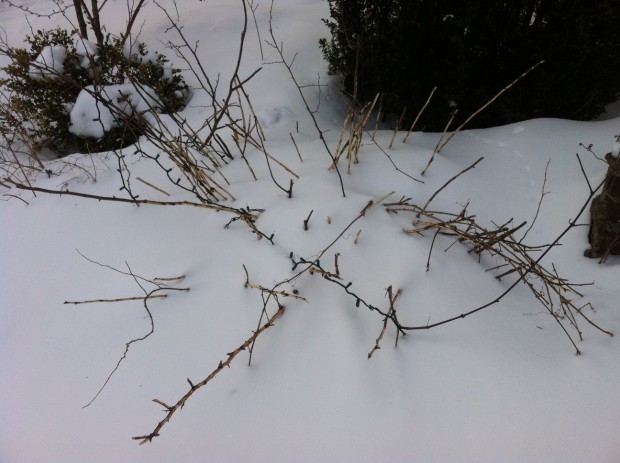 This picture from his garden is from a mature quince. Every branch which above his current snow line has no bark. The 6 feet of snow we have had so far this winter means that there is little winter food for wildlife. This damage is most certainly the result of gnawing from hungry rabbits. Though the extreme cold will take its toll, the deep snow meant the bark of this quince would become rabbit food. A shrub or tree stripped of its bark can no longer sustain the life of that limb.
This picture from his garden is from a mature quince. Every branch which above his current snow line has no bark. The 6 feet of snow we have had so far this winter means that there is little winter food for wildlife. This damage is most certainly the result of gnawing from hungry rabbits. Though the extreme cold will take its toll, the deep snow meant the bark of this quince would become rabbit food. A shrub or tree stripped of its bark can no longer sustain the life of that limb.
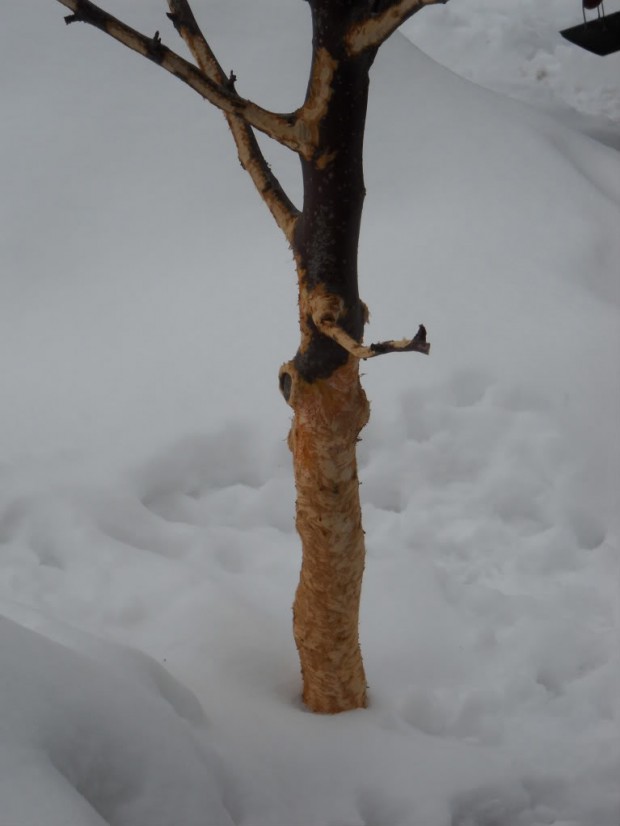 The damage to the landscape may not be apparent until the snow has melted, revealing disaster like what is pictured above. Deep snow means wildlife are struggling to find food. Deep snow can be damaging in other ways. When the sun moves higher in the sky, the light reflecting off of the snow can thaw evergreen branches. An evergreen branch brought out of dormancy by the reflected light and heat of the winter sun can burn, or die, once temperatures drop dramatically at night. Tree bark that warms during a sunny day, and then refreezes at a rapid rate may produce sunscald. Most frequent on the south side of a tree, sun scald can kill the inner bark. Winter burn, sun scald, frost cracks-these are all conditions brought on by an extraordinary confluence of extreme cold, extreme snow and sun.
The damage to the landscape may not be apparent until the snow has melted, revealing disaster like what is pictured above. Deep snow means wildlife are struggling to find food. Deep snow can be damaging in other ways. When the sun moves higher in the sky, the light reflecting off of the snow can thaw evergreen branches. An evergreen branch brought out of dormancy by the reflected light and heat of the winter sun can burn, or die, once temperatures drop dramatically at night. Tree bark that warms during a sunny day, and then refreezes at a rapid rate may produce sunscald. Most frequent on the south side of a tree, sun scald can kill the inner bark. Winter burn, sun scald, frost cracks-these are all conditions brought on by an extraordinary confluence of extreme cold, extreme snow and sun. 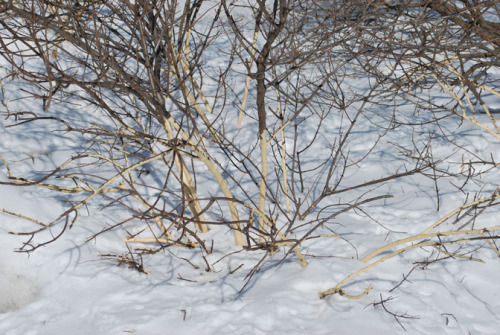 Frost cracks, or vertical splits in tree bark from extremely low temperatures, can damage a tree. These splits, though they may heal, are an ideal point of entry for disease and insects. No gardener has any control over any of this. A friend in Chicago has written that she sees frost cracks on London Plane trees now. Circumstances beyond one’s control are never easy to take, but some understanding can help relieve the shock. I have been thinking when spring comes, all will be well in my world. In fact, five weeks hence, I may have issues in my landscape that are not to my liking.
Frost cracks, or vertical splits in tree bark from extremely low temperatures, can damage a tree. These splits, though they may heal, are an ideal point of entry for disease and insects. No gardener has any control over any of this. A friend in Chicago has written that she sees frost cracks on London Plane trees now. Circumstances beyond one’s control are never easy to take, but some understanding can help relieve the shock. I have been thinking when spring comes, all will be well in my world. In fact, five weeks hence, I may have issues in my landscape that are not to my liking.
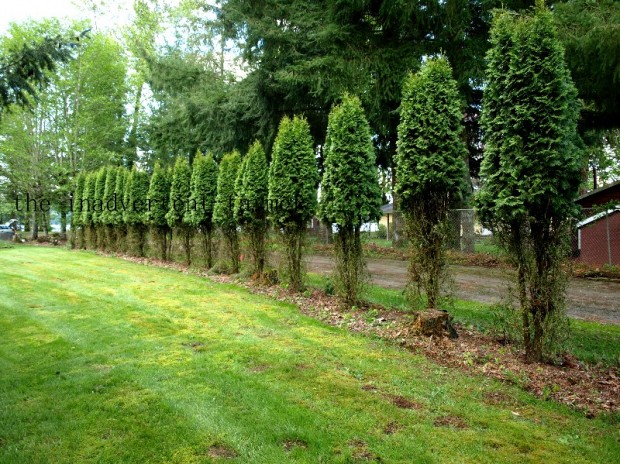 At least I have no deer. My very populated urban area is not a habitat of choice. Were I to walk to my rose garden once the snow had melted, the sight of my arborvitae denuded by hungry deer might make me black out. This gardener whose plants are pictured above-I cannot imagine their anguish. I have had severe damage to my arborvitaes from ice and wind that weighed down and splayed out long branches. Though they have all been professionally staked by an arborist, they have not completely grown out of the damage which dates back six years.
At least I have no deer. My very populated urban area is not a habitat of choice. Were I to walk to my rose garden once the snow had melted, the sight of my arborvitae denuded by hungry deer might make me black out. This gardener whose plants are pictured above-I cannot imagine their anguish. I have had severe damage to my arborvitaes from ice and wind that weighed down and splayed out long branches. Though they have all been professionally staked by an arborist, they have not completely grown out of the damage which dates back six years.
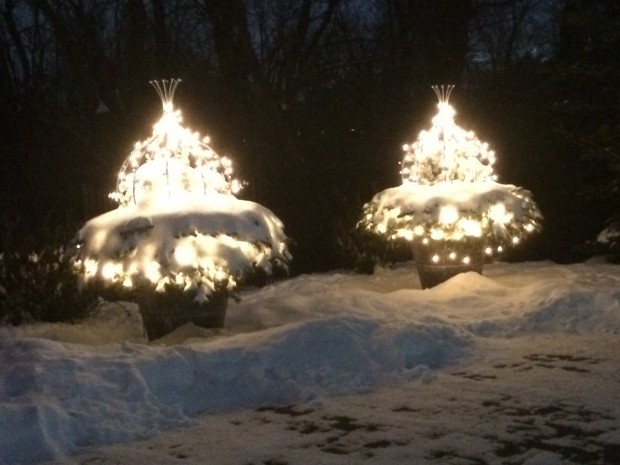 Our winter is not even close to a close. Am I beat down to the ground by the incredibly cold temperatures and relentless snow-yes. So far today we have had high winds, hail, and freezing rain. Though there is nothing I could have done to protect my plants from exposure to any of this, as usual, I have hope.
Our winter is not even close to a close. Am I beat down to the ground by the incredibly cold temperatures and relentless snow-yes. So far today we have had high winds, hail, and freezing rain. Though there is nothing I could have done to protect my plants from exposure to any of this, as usual, I have hope.
They said today on TV that this was our 4th warmest year ever. I cannot believe it. I am almost 69 years old and can’t remember a colder winter.
Dear Linda, What? I can’t remember a colder weather either. Am I missing something? We have night temperature forecasts for the last of February that are below zero. Deborah
And we gardeners never lose hope do we Deborah? As it says, “And this too shall pass.”
Stay hopeful. Oh, and thanks for your continued posts. BTW, I looked out on my deck when I got up during the night only to see the ice, the snow and the wind. But what brought a smile to my face was seeing the lights and red twigs in my beautiful Detroit Garden Works steel luminaries. Truly magnificent. Even took a picture it was so darn beautiful.
Dear Greg, your letter is a gift- a comfort. Thanks, Deborah
Though those deer-ravaged arborvitae look hideous now as a full hedge, they can be “saved” via another approach — conversion to a raised topiary hedge, perhaps rectangles? This is done often in England with arborvitae but very infrequently here (perhaps it’s a prophylactic to counter dieback of the bottom in rough winters).
Dear Judith, I have seen arborvitae hedges with this kind of damage faced down with hydrangeas-or a second layer of arborvitae. Even under the best of circumstances, arborvitae will get thin at the bottom with age. I planted boxwood in front of mine many years ago, in anticipation of that. I have never seen a raised topiary hedge of arborvitae, but I certainly would go that route before I would tear plants out, and start over. Thanks,Deborah
It’s just terrible! Like you, I have quite a collection of evergreens that were brought in from the Pacific Northwest. I was diligent about mulching aggressively and I do spray all yews and boxwoods to prevent them from drying out in the harsh winds. I do alo use twine on upright plants to prevent branches from cracking under the weight of wet snow. My boxwoods and Michigan native yews seem OK, so far, but my extensive collection of Irish yews (taxus bacchata fastiagata) seems demolished – mostly dried out with their leaves turning brown already. Should I cut them down and hope new growth will re-emerge? Should I go through the effort of importing new ones from the Pacific Northwest, with the fear that they too will be demolished, possibly, in the future? It is a real anguish … Your pictures of the deer/rabbit damage are a real heart break. I used ‘Liquid Fence’ on my yews, azaleas and rhodos and it seems to be working so far. A rare moment of optimism …
Dear Antoine, it is far too early to make any decisions about what to do. Plants that are burned from winter cold will grow out of it. The new spring growth will be normal. The best course of action is to wait and see. I would not do anything until the spring season is well underway. There is no sense stressing plants further that are already under stress. I understand exactly how you feel-distressed doesn’t begin to cover it. Deborah
I can feel your pain and it brings tears to my eyes. To loose ones garden, any part of the garden, is like loosing a close friend. Please keep us updated especially when you start to thaw out, sending good vibes your way!
Dear Carol, thanks for your vibes-I appreciate them. Plants have an incredible ability to survive. I hope this spring will prove that to be true. Deborah
Another casualty will be certain cultivars of Forsythia. I tried forcing some a few weeks ago and only got green leaves. The flower buds had all died. The one bush that was here when my house was built 75 years ago will bloom, an oldie but goodie. But, there will be other springs, and that is what we gardeners all look forward to.
Dear Mary Kay, forsythia buds are very cold sensitive-your green leaves do not surprise me. It is just discouraging to think that after such a hard winter, the spring may be hard too. My hellebores are still under 5 feet of snow! Deborah
Your words of rueful wisdom touched my soul. I so hope you are spared the worst.
Dear Michaele, I truly hope I am proved wrong. The worry may be worse than the outcome. Deborah
Hmmm. Isn’t this a chance to plant some new things after we see what hasn’t made it or is damaged? Even though we live in Michigan, in cold zone 5, there are still many plants to try. I don’t ever remember a colder winter either.
I think more about looking for microclimates for the zone 6 & higher plants and augmenting those spots with added protections as needed. I guess if we live in Michigan and want variety we have to keep rejuvenating. Our arborvitaes, spruces and yews have always come through April ice storms and wet heavy snows without lasting damage. So far!
Dear Starr, I have one yew on my driveway with definite signs of burn. I would think most damage won’t show up until the weather warms up. We’ll see. Deborah
Your post sent me looking for a quote that’s been haunting my mind these snowy days.
“In the days of the frost, seek a minor sun.” Loren Eiseley, The Judgement of the Birds.
Hold on to hope, Deborah.
Maybe tomorrow you can find a minor sun. Is there a nearby witch hazel with fat yellow buds?
Mine is now two-thirds covered with snow, but every year it keeps its promise with a flurry of yellow blooms. I’d call that at least a minor sun!
In the morning I’ll check on my little tree and report back.
Dear Kathleen, thanks for your concern! It is still very much the winter season here. We have had sun the past few days, and weather above freezing. I am glad to see some of the snow melting. If my magnolia stellata blooms as usual in March, that will help! Deborah
Dear Deborah
Over here in the UK, we too have had the most catastrophic winter with extreme flooding and brutal gales. ( if you get a chance, check out what has happened to an area of south west Britain called the Somerset levels). Land has been washed away and wildlife has been displaced. However, we have been told that we are over the worst of it and sure enough, a few tops of bulbs are beginning to show and today the sun is shining. What I am trying to say is, be strong, you and your lovely garden will see an end to your current misery . Yes, there will be many casualties but metaphorically speaking, the sun will shine eventually.
Dear Ros,I have read about your terrible weather. Water can be so destructive. I have hopes for better days, just like you. I am hoping there won’t be many casualties, but whatever comes it will still be spring. Thanks, Deborah
Hi Deborah,
Don’t be too quick to bury your rabbit-damaged shrubs & trees. I’ve seen euonymus that looked completely girdled grow out just fine in the following years. With many trees, even a small bridge of bark can sustain future growth. Yes, I, too, am an eternal optimist.
Dear Jim, thanks for this. I did advise my friend not to prune or give up on anything until he was sure he needed to. Deborah
Hang in there, spring might be later but when it does come all the good will far outweigh the bad. I sometimes feel the all too common damage of an ice storm or late frost is often much worse than a cold winter. Even the most severely damaged may recover from the roots or dormant buds and then in a season or two the losses are mostly forgotten. May peonies fix everything 🙂
Frank
I have all of the same concerns. One thing is certain: it will be an enlightening spring. Sadly my relatively new arborvitaes, planted two years ago to screen the neighbors house after we cleaned out a few dead or dying trees, look like the ones above. The deer have never touched them before, but the poor things are desperate this year. They’ll be coming out and get replaced with something else in spring; I lack patience for trying to get them to fill back out. Of course we are accustomed to lollipop trees here. The deer eat the bottom 6 feet of every cedar, good for them in an area known as Cedar Beach. I’m still looking for the perfect under planting for under the long lines of cedar trees. I suspect I’ll be looking for a long time.
You can under-plant your cedar trees with Yew, I have had good results with this combination.
Best to start with small trees as these cope better with the root-ridden ground and will grow away well.
Dear Tristan, many thanks for the good advice. I have never seen cedars and yews planted together-sounds like a great idea. Best, Deborah
I live in Massachusetts, and the biggest difference this year is that nights are colder than usual – some below zero (lowest -13) ; lot nights around 1 – 3 degrees. But weather varies a lot in New England, and so this doesn’t seem too different from a colder weather swing. Our magnolias and dogwoods come back just fine. Animal damage is another story! I would put protectors around trees and shrubs that are vulnerable; that is done here, particularly around fruit trees. But beyond animal damage, your plants may do just fine. After all, they have a wonderful protective snow cover, providing excellent root insulation. Cheers!
Dear Mary, I am going to keep your letter in my thoughts. Thanks, Deborah
We have a Forest Pansy redbud and our nurseryman joked that if it has not bloomed or leafed out by July then it might be a goner. July is our date for declaring death and damage in the garden. But we are with you in our concern about damage from this winter. We do have a 150+ year old oak but last year we put in a number of marginal trees and shrubs based on 20 years of gardening here. I doubt any of them will make it. I can see munching on shrubs from indoors. Ugh.
Dear Linda, this is actually great advice. Nature can surprise you. Don’t give up on those trees and shrubs until July, as they say! Thanks, Deborah
Deborah, Just a comment to Tristan and Erin. Arborvitae of any species are deer food and their greatest love are yews. I live in the country and both take a loss even when there is little snow. I live with the arbs because they do screen a electric train line, but have replaced all yews with boxwood. Chamaecyparis l. ‘Sullivan’ seems to be deer resistant and grows in a little shade. So far the deer have not touched them and they seem in good shape despite the weather.
Hoping for a bright tomorrow!
Dear Janice, thanks for this. I have also heard that deer disdain Green Giant arborvitae-but you need so much room to grow them. I don’t have deer in my garden, so I don’t know very much about the topic. Best, Deborah
Unfortunately the deer do not seem to read the same publications we do! I planted five nice large Green Giants to hide my husbands barn and the next winter they ate everyone. The next winter I put netting around them and they did recover quite well. I buy inexpensive bird netting and put stakes in the ground around the plants I want to save and put the netting up around that. It seems to work well. The tough job is taking them all down in the spring.
Deborah, I must tell you how much I have enjoyed your blog. I’m just entering my seventh decade and cannot think that I will give up my business or gardening. There is always a challenge and I think that is what keeps us gardeners strong. I find myself thinking as you do, but do not write as eloquently as you. A deep thank you for getting us through this trying winter.